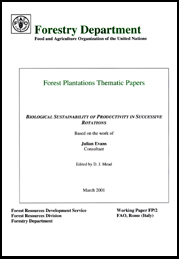


Based on the work of
Julian Evans
Consultant
Edited by D. J. Mead
March 2001
Forest Plantations Thematic Papers
Forestry Department |
Working Paper FP/2 |
Disclaimer
The Forest Plantation Thematic Papers report on issues and activities in forest plantations as prepared for FRA 2000. These working papers do not reflect any official position of FAO. Please refer to the FAO website (http://www.fao.org/forestry) for official information.
The purpose of these papers is to provide early information on on-going activities and programmes, and to stimulate discussion.
Comments and feedback are welcome.
For further information please contact:
Mr. Jim Carle, Senior Forestry Officer (Plantations and Protection),
Forest Resources Development Service
Forest Resources Division
Forestry Department - FAO
Viale delle Terme di Caracalla
I-00100 Rome (Italy)
e-mail: [email protected]
For quotation:
FAO (2001). Biological Sustainability of productivity in successive rotations. Report based on the work of J. Evans. Forest Plantation Thematic Papers, Working Paper 2. Forest Resources Development Service, Forest Resources Division. FAO, Rome (unpublished).
2. Site change induced by plantation forestry
2.1 Assessing changes in soil
2.2 Soil chemical status2.2.1 Soil as a mineral store
2.2.2 Nutrient removal
2.2.3 Litter and residues
2.2.4 Measured changes in soil chemistry2.3.1 Site preparation and planting
2.3.2 Impact of tree growth
2.3.3 Indirect impact of vegetation suppression
2.3.4 Harvesting damage
3.1 Pest and disease incidence in monocultures
3.2 Risks associated with plantation forestry practices
3.3 Storms and fire
4. Evidence of productivity changes
4.1 Productivity change in successive rotations of forest plantations
4.1.1 Data limitations
4.1.2 Spruce in Saxony and other European evidence
4.1.3 Pinus radiata in Australia and New Zealand
4.1.4 Pinus patula in Swaziland
4.1.5 Chinese fir in sub-tropical China
4.1.6 Teak in India and Java
4.1.7 Southern pines in the United States
4.1.8 Other evidence
5. Interventions to sustain yield
5.1 Genetic improvement
5.2 Role of different silvicultures
5.3 Fertilising
5.4 Site preparation establishment practices
5.5 Organic matter conservation
5.6 Holistic management
List of Working Papers on forest plantation: Thematic Paper Series